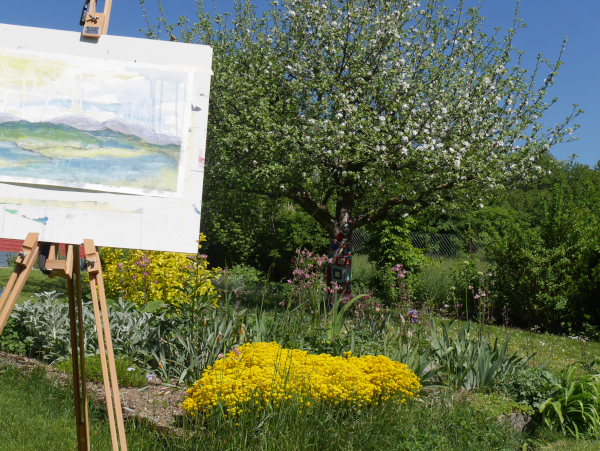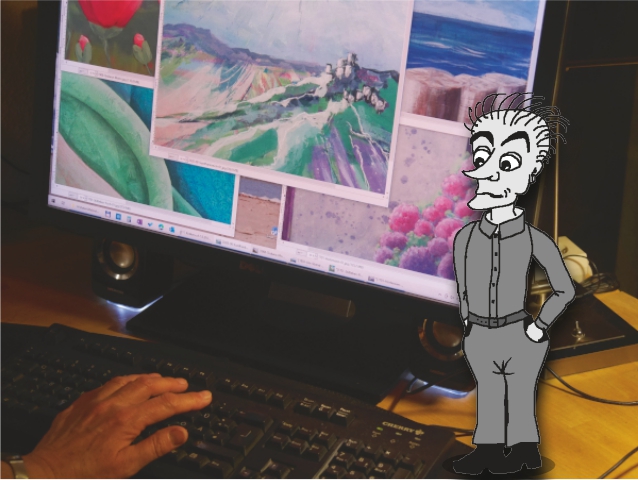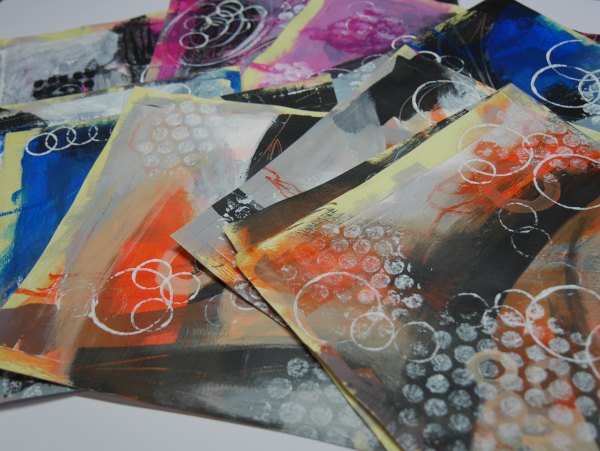Plein-air-Malerei – Malen an der frischen Luft, das klingt irgendwie romantisch, oder?
Wahrscheinlich seht auch ihr Claude Monet mit Staffelei an der Seine stehen und seinen berühmten Sonnenaufgang malen. Oder einen anderen der Impressionisten, die die Stimmung und das Licht der Umgebung einfangen wollten.
Das Malen in der Natur wurde möglich durch die Mitte des 19. Jahrhunderts erfundenen Fertigfarben in Tuben, die man mitnehmen konnte. Also packt man Palette, Pinsel, Farben, Lappen und Leinwand in ein Köfferchen, schultert die Feldstaffelei und marschiert los.
So ungefähr habe ich mir das vorgestellt, als ich letztes Jahr (LINK) einiges zusammengestellt habe, das ich ins Wohnmobil und auf Reisen mitnehmen wollte. Auch in den letzten zwei Wochen waren die Sachen dabei, als wir eine Tour durch Süddeutschland gemacht haben. Ausgepackt habe ich sie allerdings nur ein einziges Mal.
Warum? Weil wir unterwegs waren, und zwar fast jeden Tag. Viel herumlaufen, allerlei anschauen, nachmittags auf Campingplatz oder Wohnmobil-Stellplatz ankommen. Weil es dann nicht mehr lohnte (und ich auch keine Lust mehr hatte), alles aufzubauen und zu malen.
Nach ersten Erfahrungen das Equipment überdenken
Zuhause im Atelier können Palette und Pinsel, Staffelei und angefangenes Bild liegen und stehen bleiben. Unterwegs muss ich am Ende der Malsession alles einpacken und bei der nächsten Gelegenheit wieder auspacken.
Mal eben eine halbe Stunde zwischendurch ein paar Pinselstriche, das funktioniert unterwegs nicht, jedenfalls nicht für mich. Oder nur, wenn wir länger an einem Ort sind und ich – gutes Wetter vorausgesetzt – alles stehen lassen kann.
Auf der einen Seite hatte ich zwar diverse Farben dabei, aber mir fehlten zum Beispiel Ölpastellkreiden, die ich gerne mit Acrylfarben kombiniere. Und auch Acrylbinder zum Versiegeln einer Schicht hatte ich vergessen.
Was funktioniert hat, waren die abendlichen Collagen für mein 100-Tage-Projekt. Die konnte ich am Tisch machen, ohne die Gefahr, überall im Wohnmobil Farbe zu verteilen.
Aber gerade dieses Farbe-verteilen hat mir gefehlt, und ich habe überlegt, ob ich nicht eine Art Kompromiss finde.
Der Plan:
Wir haben einen alten Klapptisch dabei. Wenn ich kleinere Holzplatten oder Papier in handlichem Format einpacke, dann könnte ich direkt neben dem Wohnmobil an diesem Tisch arbeiten, und zwar an mehreren Bildern parallel, wie ich das ja auch zuhause gerne mache.
Ich möchte eine flache Kunststoffdose mit Deckel als Palette nutzen, weil ich sie fest verschließen und mitsamt den Farben transportieren kann.
Die Staffelei und größere Maluntergründe werden nur ausgepackt, wenn wir länger an einem Ort bleiben.
Eine Materialliste soll helfen, nichts Wichtiges zu vergessen. Ich habe im Urlaub schon angefangen, sie zu schreiben.
Und für Schlechtwetter-Tage gibt es Collagematerial und – für jedes Wetter – Skizzenbücher. Das wäre doch eine gute Gelegenheit, sich endlich mal mit ihnen anzufreunden.
Was nehmt ihr mit auf Reisen? Was für Erfahrungen habt ihr mit dem Malen unterwegs gemacht? Habt ihr Tipps oder Anregungen, die vielleicht auch für andere hilfreich sind? Ich freue mich über eure Kommentare zu diesem Beitrag.
Painting on the go (2): Is it worth lugging all that “stuff” with you?

Plein-air painting – painting in the fresh air sounds kind of romantic, doesn’t it?
You will probably also see Claude Monet standing by the Seine with his easel and painting his famous sunrise. Or another of the Impressionists who wanted to capture the mood and light of the surroundings.
Painting in nature was made possible by the ready-made paints in tubes that you could carry with you, invented in the mid-19th century. So you pack your palette, brushes, paints, rags and canvas in a little case, shoulder your field easel and off you go.
That’s roughly how I imagined it when I put together a few things last year (LINK) that I wanted to take with me in the motorhome when traveling. The things were also there in the last two weeks when we did a tour through southern Germany. I only unpacked it once though.
Why? Because we were out and about almost every day. Walking around a lot, looking at all sorts of things, arriving at the campsite or camper place in the afternoon. Because then it was no longer worthwhile (and I didn’t feel like it anymore) to set everything up and paint.
Reconsider the equipment after initial experience
At home in the studio, the palette and brush, the easel and the started painting can stay where they are. On the way I have to pack everything up at the end of the painting session and unpack it again at the next opportunity.
Just a few brush strokes for half an hour in between, that doesn’t work on the go, at least not for me. Or only when we’re in one place for a longer period of time and – assuming the weather is good – I can leave everything behind.
On the one hand, I had various colors with me, but I was missing, for example, oil pastels, which I like to combine with acrylic paints. And I also forgot acrylic binder to seal a layer.
What worked were the evening collages for my 100 day project. I could do this at the table without the risk of spreading paint all over the motorhome.
But it was precisely this paint-spreading that I missed, and I thought about finding a kind of compromise.
The plan:
We have an old folding table with us. If I pack smaller wooden boards or paper in a handy format, then I could work on this table right next to the motorhome, on several paintings at the same time, as I like to do at home.
I would like to use a flat plastic box with a lid as a palette because I can close it tightly and transport it including the paints.
The easel and larger painting surfaces are only unpacked if we stay longer in one place.
A list of materials should help ensure that nothing important is forgotten. I started writing it while I was on vacation.
And for bad weather days there is collage material and – for any weather – sketchbooks. It would be a good opportunity to finally make friends with them.
What do you take with you when you travel? What experiences have you had with painting along the way? Do you have any tips or suggestions that might be helpful for others? I look forward to your comments on this post.

